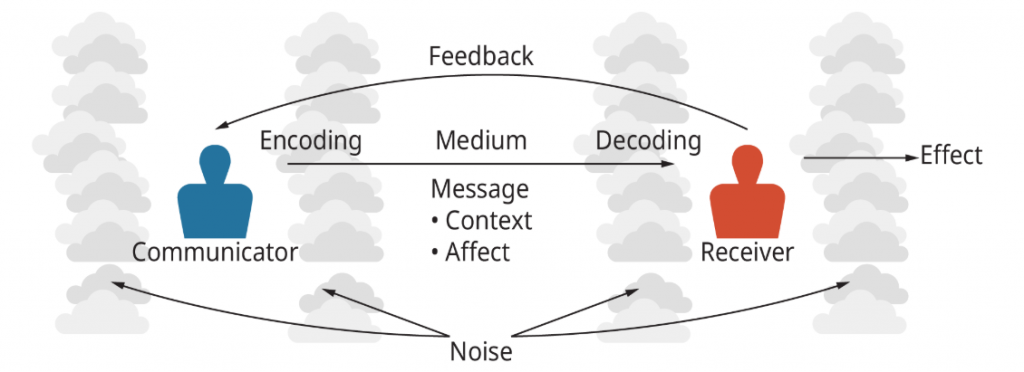10.1 The Communication Process
No one can go an entire day without any form of communication. It is even unlikely to happen within the first hour of the morning. Communication is the act of relaying messages, either verbal or non-verbal, from one person or entity to another person or entity through signs, symbols, orsyntactics. Communication is not necessarily talking to someone. It could be that when driving to a job in the morning, the act of driving itself through stopping, using turn signals, and at times, honking the horn are all forms of communication. In a way, one of the biggest safety features of the car, is the driver’s ability to be communicable while driving in order to drive safely. Communication is how people interact within the environment outside themselves and in their purview. When using person-to-person communication, it is the communication process when a communicator encodes a message and a receiver decodes a message[1].
Figure 1 outlines a simple communication process where one individual sends an encoded message to another individual. The second individual then decodes it and offers feedback.

Two very important parts of the communication process is the encoding and decoding of messages. Encoding is the process where individuals initiating the communication process send out a set of systematic symbols[2]. For example, when saying, “Hello, how are you today,” that is using the systematic symbol of language to create a common code for the receiver. Decoding is the receiver accepting the encoded message as an interpretation, after which the receiver provides feedback which is, in many cases, the final stage, and usually communicates a message of acknowledgement of the coding process[2]. In this example, the decoding is the individual recognizing the greeting and responding with “I’m fine, how are you?” and then the process either continues or ends.
Another part present in the communication process is the introduction of noise. Noise is the way encoding and decoding can be distorted by a variety of elements[2]. Noise can come from a plethora of problems including physical distractions, poor channels, and cultural disconnect.
Inside of a learning organization such as a university, the prevailing feature is that schools should maintain an institutional framework for communication and provide clear protocols of information flow through chain of command [3]. This is beneficial to the process of encoding, receiving feedback, and avoiding noise distortions
Review Questions:
- What is communication and the communication process?
- What are two important parts of the communication process?
The act of relaying messages either verbal or non-verbal from one person or entity to another person or entity through signs, symbols and syntactics
When a communicator encodes a message and receiver decodes a message
The process where individuals initiating the communication process
During the communication process the receiver accepts the encoded message as an interpretation

